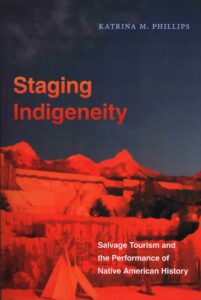Book review: Staging Indigeneity: Salvage Tourism and the Performance of Native American History
 Reviewed by Karl Hele
Reviewed by Karl Hele
Katrina Phillips’ Staging Indigeneity: Salvage Tourism and the Performance of Native American History explores three outdoor performances created by non-Indigenous that claim to tell the story, in part or in full, of the American Indian albeit with a good dose of dramatic license. To understand each of the plays – Happy Canyon Indian Pageant, Unto These Hills, and Tecumseh! – Phillips utilizes the idea of salvage tourism. This concept encapsulates the idea of salvage anthropology (i.e., document Indigenous cultures before extinction) and heritage tourism (i.e., experience the living past). Thus, the performances as salvage tourism utilize Indians, in their pristine non-modern forms, to explore and expound on notions within the American national identity. Additionally, the tourist experiences the past in a familiar narrative – eventual white domination, colonization, and vanishing of the ‘real’ Indian – in a ‘sanctuary of safety and security’. (7) These plays, according to Phillips, each created at a particular time, need the idea of the Indian to define what is to be American and to define the exceptionalism of the American historical experience. Simply, plays like Tecumseh! allow tourists to revel in the dramatic destiny of America, the defeat of the Shawnee who threatened Manifest Destiny, albeit in a melodramatic formula. The performances collectively offer a “narrative of conquest that underplayed the very action of conquest” (141).
Phillips divides her book into six chapters plus an introduction and conclusion. Each play has two chapters dedicated to exploring its origins and history as well as its contemporary existence. Happy Canyon Indian Pageant situated in Pendleton, Oregon, focusses on the idea of the Wild West and Oregon Trail. Unto These Hills situated in Cherokee North Carolina tells a story of the Eastern Band of Cherokee’s refusal to move west. Finally, Tecumseh! set in Chillicothe, Ohio, tells a romanticized story of Tecumseh’s life and efforts to create a pan-Indian movement to resist American expansion. All three plays came about to utilize the Indian and history infused with good doses of dramatic license to develop local economies through tourism. Whereas Unto These Hills and Tecumseh! denied Indigenous involvement for decades, The Happy Canyon Indian Pageant, while initiated by the business leaders in Pendleton, involved the nearby Confederated Tribes of the Umatilla Indian Reservation in the production. Unto These Hills organizers ignored the Eastern Band of Cherokee whose history the performance purported to tell. Tecumseh! took place in Ohio far away from the relocated Shawnee nations, albeit in the 21st century, it has hired Indigenous actors to perform the titular role. All three performance pieces faced contestations of their representations of history and Indigenous peoples from their inception. Tecumseh! for instance includes a romance with a white woman, which never happened historically. Despite the contestations of the plays, albeit with minor updates for modern sensibilities, the performances continued into the 21st century. Only Unto these Hills collapsed under the weight of economic changes, such as alternative and competing forms of entertainment, tourism changes, and dramatic fallacies. Yet, the other two plays continue despite similar challenges, which Phillips attributes to the greater connection of the stories with the idealized romanticized past that speaks to contemporary fears and ideas of Americanism.
Overall, this is an excellent exploration of the importance in understanding the outdoor performances created by non-Indigenous people for economic and entertainment purposes while purporting to tell a historical story. By applying salvage tourism, Phillips deftly guides the reader through the need by white America to see Indians as pristine, romantic, and authentic, yet safely confined to the past while ignoring the messiness of American Indian Wars and subsequent Indian policies. The performances appeal because of their claim to authenticate while whitewashing the past and confirming American destiny, exceptionalism, and standing in the world. While Indians are important to each performance, we seemingly vanish as the American triumphantly progresses. I highly recommend this book for those interested in the historical and contemporary nature of staging historical dramas that involve claimed Indigenous pasts, as well as those interested in simply another aspect of how settlers use the image of the Indian to define an image of themselves. It is a truly thought-provoking work.
Katrina M. Phillips, Staging Indigeneity: Salvage Tourism and the Performance of Native American History. Chapel Hill: University of North Carolina Press, 2021.
ISBN: 978 1469662312


